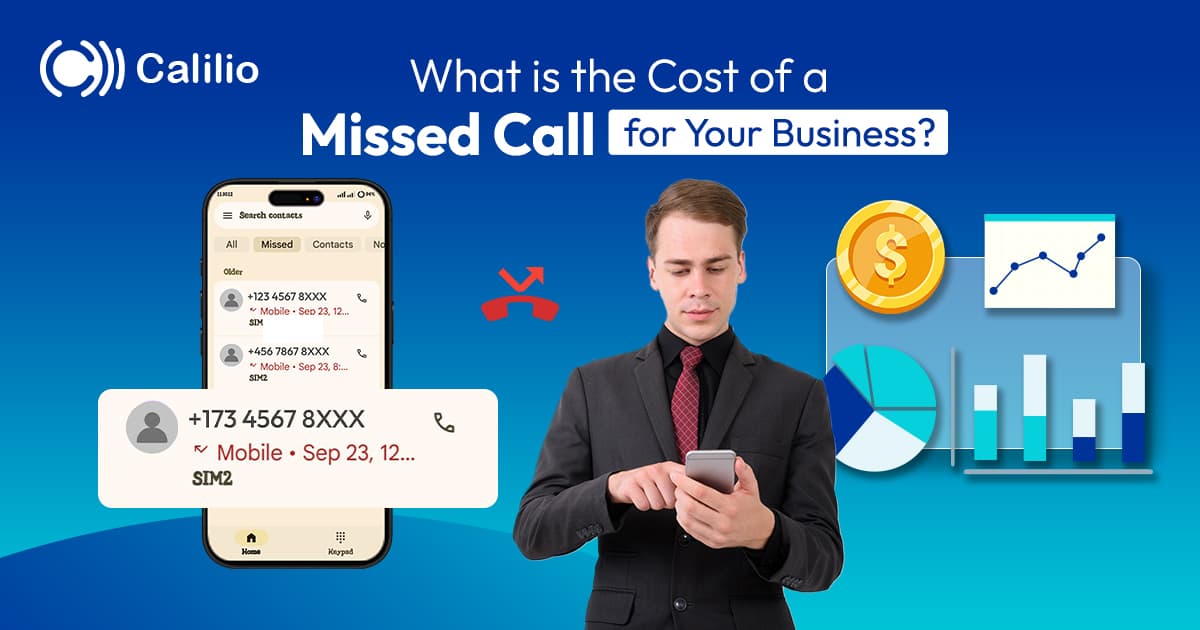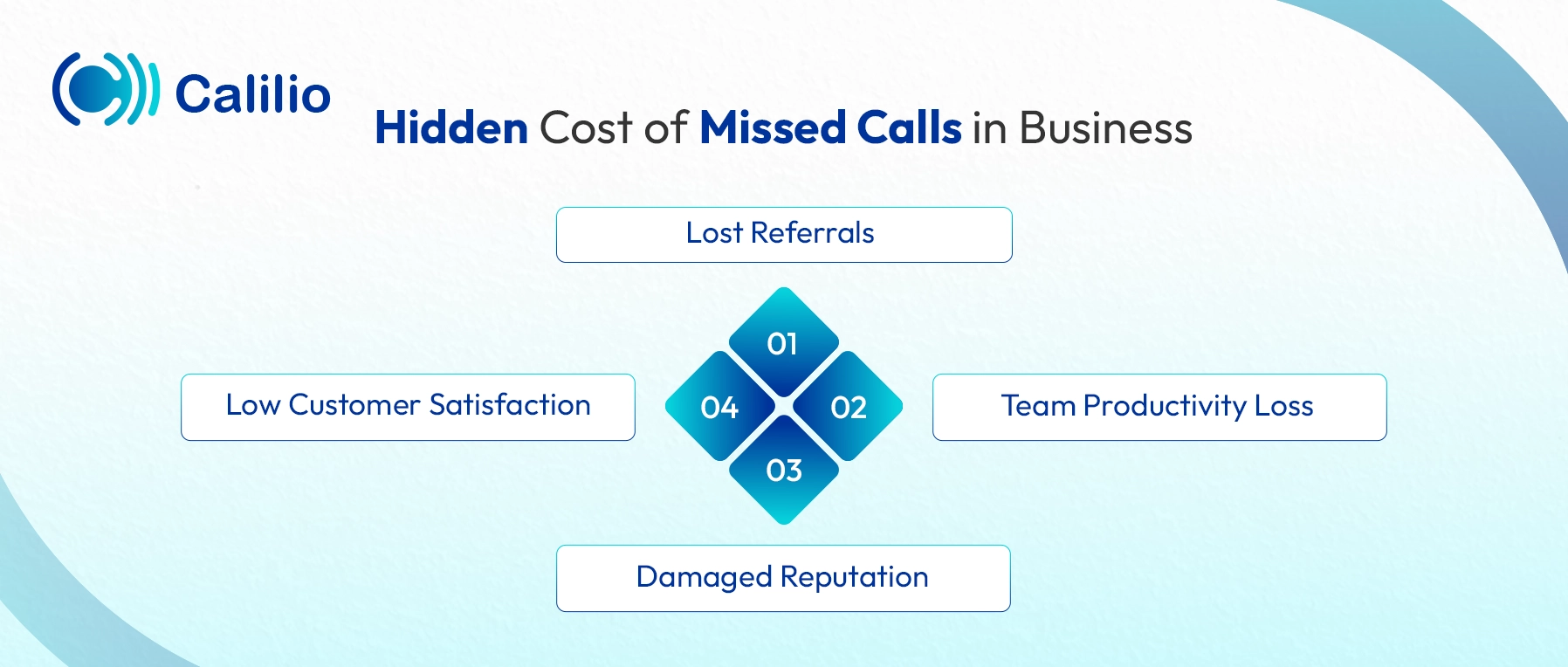The Cost of Missed Calls in Business & How to Avoid Them

Missed calls may seem harmless, but for businesses, they come with costs that are often overlooked. The hidden cost of a missed call is not only financial; it can mean a lost sale, a frustrated customer, or a damaged relationship. Over time, these small moments add up to lost revenue and weaker customer loyalty.
The good news is that businesses don’t have to accept missed calls as unavoidable loss. By recognizing the cost of missed calls and addressing their root causes, you can protect revenue and strengthen customer relationships.
In this blog, we’ll learn how to calculate the cost of missed calls, their impact on business, and practical steps you can take to reduce them.
Key Highlights:
A missed call creates a communication gap that leads to lost sales opportunities, slower response times, and reduced customer satisfaction.
The cost of missed calls can be calculated with the formula (Average Value per Customer × Conversion Rate) × Number of Missed Calls.
Businesses often miss calls due to limited staff, high call volumes, outdated systems, after-hours gaps, or remote work challenges.
Tools such as virtual business phone systems, call forwarding, IVR, call queues, and voicemail-to-email help reduce missed calls and their impact on business.
What Does a Missed Call Mean for Your Business?
A missed call means someone tried to reach you, but you didn’t answer before the call ended. It usually happens when you’re busy, away from your phone, or unable to notice it ringing. While this might seem minor, missed calls can have a bigger impact, especially in business communication.
For businesses, a missed call creates a communication gap that can affect revenue and customer relationships. It often results in lost sales opportunities, slower response times, and lower customer satisfaction. This is why many companies track missed calls and use business phone systems or call center software to ensure important calls are never overlooked.
How to Calculate the Cost of a Missed Call?
To calculate the cost of a missed call, multiply your average value per customer by your conversion rate, then multiply that result by the number of missed calls in the chosen time period.
Mathematically,
Cost of a Missed Call = (Average Value per Customer × Conversion Rate) × Number of Missed Calls
Where,
- Average Value per Customer represents the typical revenue you earn from one customer or sale.
- Conversion Rate means the percentage of callers who usually become paying customers.
- Number of Missed Calls represents the total number of calls that went unanswered during a specific period (daily, weekly, or monthly).
Common Reasons Businesses Miss Calls
Businesses often miss calls due to limited staff, high call volumes, after-hours inquiries, or technical problems with outdated phone systems. Calls can also be missed in remote work setups without centralized systems, or from simple human error when no one picks up.

- Limited Staff Availability: Small teams with limited staff find it hard to answer all calls during busy hours, leaving some customers waiting or unanswered.
- High Call Volume: Even with enough staff, calls can flood in all at once. Without call queueing or routing systems, many callers hang up before an agent becomes available.
- After-Hours Calls: Many customers call outside business hours. If there’s no evening or weekend coverage, those calls go unanswered entirely.
- Technical Issues: Old or unreliable phone systems can drop calls, send them to the wrong extension, or fail to notify staff of voicemails.
- Lack of Backup Options: If there’s no process for handling unanswered calls, like call forwarding, voicemail alerts, or an answering service, calls just go unanswered.
- Remote or Hybrid Work Challenges: As more teams work remotely, calls can slip through the cracks if there is no centralized business phone system in place.
- Human Error: Sometimes, calls are missed simply because no one notices the phone ringing, or agents assume someone else will pick it up.
Stop Losing Leads to Missed Calls. Start Answering Every Call with Calilio Today
What is the Cost of Missed Calls in Business?
The cost of missed calls in business can be around $12.50 per call or over $125,00 per annum in lost opportunities. These costs come from lost sales, wasted marketing spend, and reduced customer lifetime value. Over time, they reduce both short-term income and long-term growth potential.
1. Lost Sales Opportunities
If a potential customer calls to inquire or place an order but cannot reach you, that revenue is gone. Even a small number of missed calls can add up to thousands of dollars in lost sales each month.
2. Wasted Marketing Spend
Businesses spend heavily on advertising and promotions to make the phone ring. Each unanswered call means marketing dollars spent without generating returns, reducing overall campaign effectiveness.
3. Reduced Customer Lifetime Value
A single missed call might not only lose an immediate sale but also the long-term value of that customer. For businesses where repeat purchases are common, the financial impact multiplies quickly.
Hidden Cost of Missed Calls in Business
Missed calls create hidden costs like reduced referrals, frustrated customers, and a damaged brand reputation. They also waste team time on follow-ups and corrections, reducing overall efficiency.

1. Lost Referrals
Happy customers often bring in new business by telling others about their good experiences. But if their calls go unanswered, they may stop recommending your company. That leads to fewer referrals and slower growth.
2. Team Productivity Loss
When calls are missed, staff often spend extra time chasing down customers, rescheduling, or fixing preventable problems. This slows progress on other important work and reduces overall efficiency.
3. Damaged Reputation
Your reputation is built on every customer interaction. Missing calls too often makes your business look unprofessional or uninterested. If that continues, people are less likely to trust you or recommend you to others.
4. Low Customer Satisfaction
When people take the time to call, they expect someone to answer. If they’re met with silence or endless ringing, frustration sets in quickly. That negative experience can push them to look for another business that seems more responsive.
How to Reduce the Cost of Missed Calls in Business?
Businesses can lower the cost of missed calls by using cloud-based phone systems with call routing, voicemail, and call queue features to ensure customers always reach someone. Regular monitoring and team training further improve response times and reduce lost opportunities.
I. Use a Virtual Business Phone System
A VoIP-powered cloud-based phone system lets you answer calls from any device, in the office or on the go. With features like number sharing and call forwarding, customers can always reach your team. This makes communication smoother and reduces missed calls.
II. Set Up Call Forwarding and Routing
Forward calls to available team members or route them to the right department with IVR (Interactive Voice Response). This prevents calls from being lost when one agent is busy or unavailable.
III. Implement Call Queues
During peak hours, call queues keep customers on hold instead of letting the call drop. Callers wait for their turn, which reduces the risk of unanswered calls. It helps manage peak-hour traffic and reduces the chance of losing potential customers.
IV. Offer Voicemail and Callback Options
Voicemail and callback options give customers an alternative when agents are unavailable. Instead of abandoning the call, customers can leave a message or request a callback. This keeps communication open and prevents missed calls from turning into lost opportunities.
V. Use Shared Business Numbers
With shared numbers, multiple agents can answer calls made to a single business line. This increases availability since any free agent can respond. It ensures customers reach someone quickly, without waiting for a specific person.
VI. Monitor and Analyze Calls
Tools like AI-generated call reports provide insights into missed calls, peak call times, and response patterns. These insights help managers optimize staffing and reduce unanswered calls.
VII. Train Teams for Responsiveness
Technology alone is not enough; your team should treat every incoming call as a priority, responding quickly and professionally. Training helps them handle calls better, avoid delays, and reduce missed opportunities.
Conclusion
Missed calls may appear small, but their impact on business is significant. From lost sales to reduced customer trust, the hidden cost of missed calls can silently affect growth. You can prevent these losses by using a virtual business phone system, setting up smart call management features, and training teams to respond effectively.

Use Promo Code: CALIBF50 to claim your Thanksgiving discount.
Get Virtual Numbers – Local, Mobile & Toll-Free from 100+ Countries
Crystal-Clear Calls Starting at Just $0.0153/min
Free USA/Canada Number + $1 Credit after subscription
AI-Powered VoIP with Smart Call Insights and Analytics
Reliable and Scalable for Growing Businesses
24/7 Human Support whenever you need help


Frequently Asked Questions
What is the average cost of a missed call for a business?
The average cost of a missed call varies by industry, but recent studies show it costs around $12.50 per call.
Which industries suffer most from missed calls?
How much revenue do businesses lose annually due to missed calls?

Still have questions?
Can’t find the answer you’re looking for? Please chat with our friendly team.
Stay in the loop
Get the latest call insights, trends, and updates delivered straight to your inbox.
By subscribing, you agree to receive updates from Calilio.
You can unsubscribe anytime.
Phone numbers
Get International Phone Numbers
Singapore
|Australia
|New Zealand